
Author Amy Stross
A few months ago I reviewed Amy Stross’s book The Suburban Micro-Farm for Mother Earth News. As I read the book I thought “man alive, this gal is like my gardening sister from another mother.”
Her suggestions are practical and realistic and she doesn’t varnish over her failures or discount her remarkable successes.
After reading her book, I got in touch and asked if she would write an article for The Survival Gardener when she got a chance, and she graciously agreed to do so.
Many of us plant-lovers and edible landscape enthusiasts have dealt with some neighborhood disapproval – and so has Amy. I think you’ll appreciate her thoughts on keeping your neighbors close and your edibles closer. -DTG
Improve Neighbor Relations with These Tips for the Edible Landscape
by Amy Stross
While farming is a tradition in wide-open, rural spaces, it does not share the same social acceptance in lawn-centric residential areas. In fact, differing opinions may collide at the property line. Follow these tips for improved neighbor relationships and a productive edible landscape that everyone can approve of.
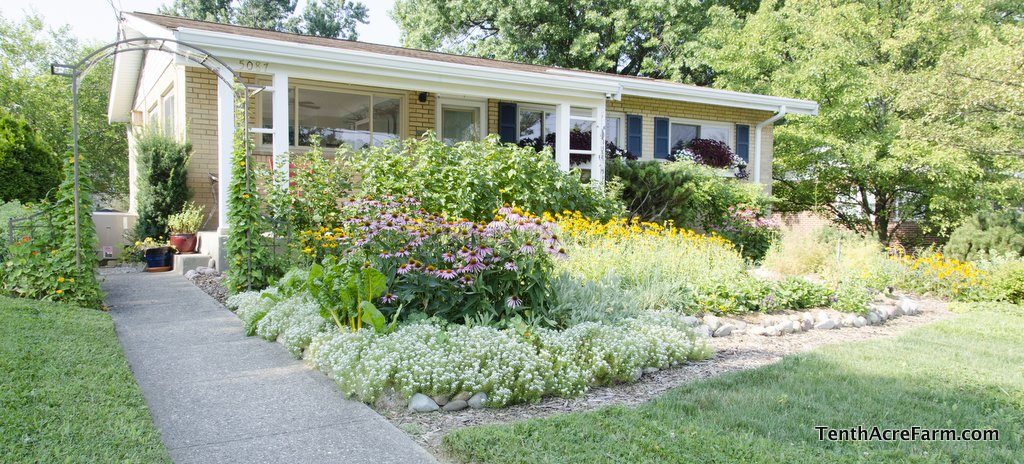
Amy’s edible front yard including currant bushes, black raspberries, strawberries, lots of herbs, and Swiss chard, passively irrigated from the roof. Not pictured, but also in the front yard, are three cherry trees.
Farm Your Yard and Have Your Neighbors, Too
If you enjoy having a garden in your yard, you may have to manage neighbor relations, especially if they aren’t amused with your activities.
There are two ways to tackle this challenge:
(1) You can focus on how to walk the tightrope of relationship and navigate communication
or
(2) You can focus on edible landscaping techniques to create a beautiful, yet productive, front yard garden that wows the neighbors.
I think doing both is a recipe for success.
I’ve had many people tell me with a great deal of irritation and assuredness that neighbors have no business sticking their nose where it doesn’t belong, so they have no plans to change their gardening practices.
I totally agree — we are certainly entitled to a certain amount of liberty on our side of the fence. However, having good neighbor relations can make living in close proximity to others more enjoyable.
With the following tips, everyone wins. If you would like neighbors to respect your privacy and interests, you’ll need to offer your respect to their perspective on life, too.
Negotiation and compromise don’t come naturally for most of us. Just about everybody on any side of an argument believes that they are “right”. But these negotiation skills—valuable in all aspects of life—are worth giving a try.
Model What You Wish To See (2 examples)
The following are two examples of interactions I had with neighbors that could have gone poorly if I had reacted with my gut. Instead of lashing out, staying positive allowed me to have a more pleasant experience with my own gardening pursuits.
I calmly (yet stubbornly) built my edible landscape which gave them a visual for what is possible. I needed to bridge the gap between manicured landscape and a food producing system. When I started digging up my front yard to “grow food”, I couldn’t expect my neighbors to know what it would ultimately look like.
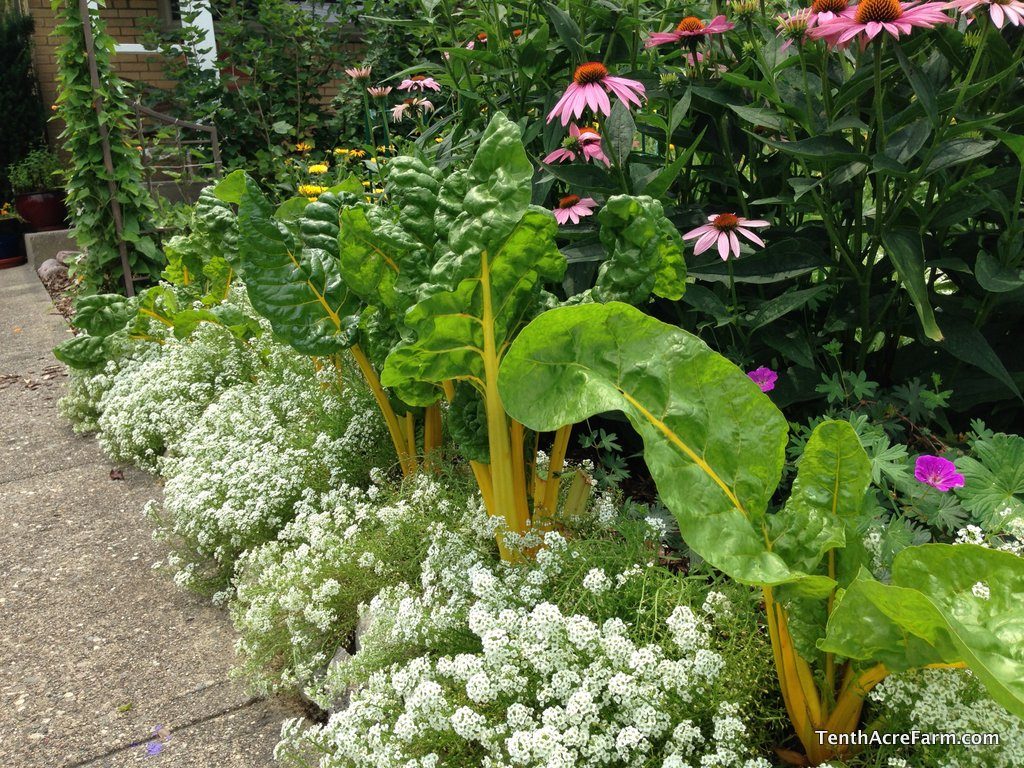
Yellow Swiss chard in the edible landscape as a sidewalk border.
Some were struggling to sell their houses, and they didn’t need an eyesore to reduce property value or scare away potential buyers. All they saw in the beginning of my project were mounds of dirt and ditches.
As humans, we are more accepting of that which has some connection and likeness to our current view of reality. Creating this bridge helped me transform a handful of lawn purists into gardeners and allies!
Example #1: Here’s a Side of Guilt
You may have to deal with a few pesky neighbors who enjoy spraying their side of the fence with herbicides and pesticides.
When I began my edible yard project, I was concerned about our next-door neighbor’s lawn chemicals draining into our yard. My husband explained the problem to him. “Would you be interested in stopping the chemical lawn treatments or switching to the organic version?”
We offered to pay the difference in price, explaining that we were growing food, and trying to do it without chemicals.
The neighbor replied, “You know, I’ve been getting the lawn treatment for years out of habit. I don’t even know why I was doing it. I’m just going to cancel it.” It was the most amazing response we could have hoped for. Hint: Pay garden-friendly neighbors in garden produce!
When approaching a neighbor whose yard practices may affect the health or safety of your edible crops, stick to the facts:
“We’re growing edibles, and trying to do it without chemicals, but your yard drains into ours, so is there anything we can do about this? Here is what I’m willing to do to meet you in the middle.”
Don’t use guilt, blame, or accusations. Chastising neighbors for their actions is unlikely to make them feel like helping you out. In fact, it could incite more abusive tactics.
Example #2: Keep the Status Quo
One neighbor with an interest in immaculate lawns was particularly distressed when he saw us digging up the front yard in late winter. We’ll call him ‘Grouchy Neighbor’ (GN). Of course, GN couldn’t have known my ultimate vision of a tidy, edible landscape.
He riled up a few other retired neighbors who enjoyed their lawns, and they glared at our progress with a judging eye from a distance.
Once mid-summer rolled around, the front yard garden was in full swing. Flowers bordered neat curvy rows with rock borders. Our landscape was much greener than many surrounding yards because of our passive rain catchment system that caught water from the roof for irrigation.
That’s when GN humbly came over and asked for a tour of the edible landscape. It took a lot of courage for him to come over after making his campaign against front yard gardens. Luckily, I had remained friendly toward him, so he felt comfortable enough to come over and see what was going on for himself.
GN was shocked to learn more about the landscape—the water catchment system, the different combinations of plants, and how they benefited each other to create a functional mini ecosystem.
It had never occurred to him that there could be so much thought and intentionality put into a landscape. He was so impressed that he called a few other retired fellas over to see. Then he offered the ultimate olive branch: A portion of his backyard in which to expand my gardening operation.
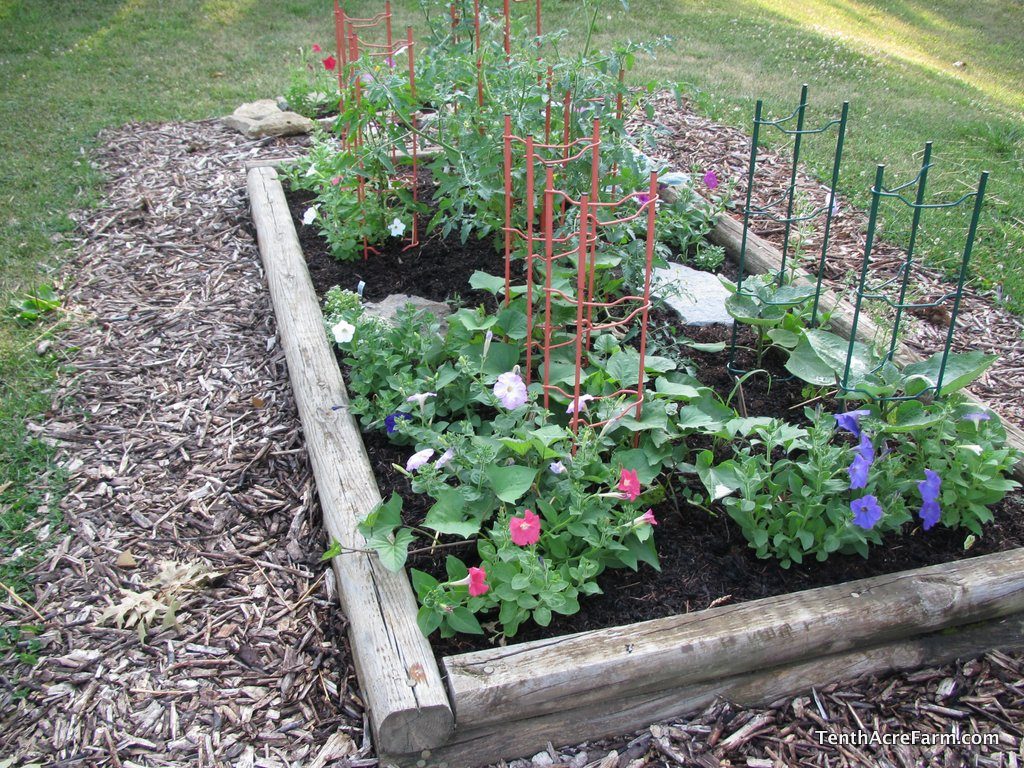
Raised bed in my neighbor’s yard growing sweet potatoes, eggplant, and tomatoes in this particular year.
My late father-in-law always said, “You get more with sugar than you do spice.”
3 Edible Landscape Tips for the Neighbor-Friendly Front Yard
These tips will help you grow a productive and low-maintenance edible front yard that keeps the neighbors happy.
Plant Edible Perennials
Conventional landscapes are filled with perennials — a hedge of bushes lining the front of the house, a specimen tree to provide interest, shade, or privacy; a mass of perennial flowers to add an aesthetic punch.
The perennial landscape is popular because it doesn’t need to be replanted every year. The permanent plants anchor the landscape year-round. Try swapping out those non-productive perennials for some food-bearing perennials to achieve the same goal!
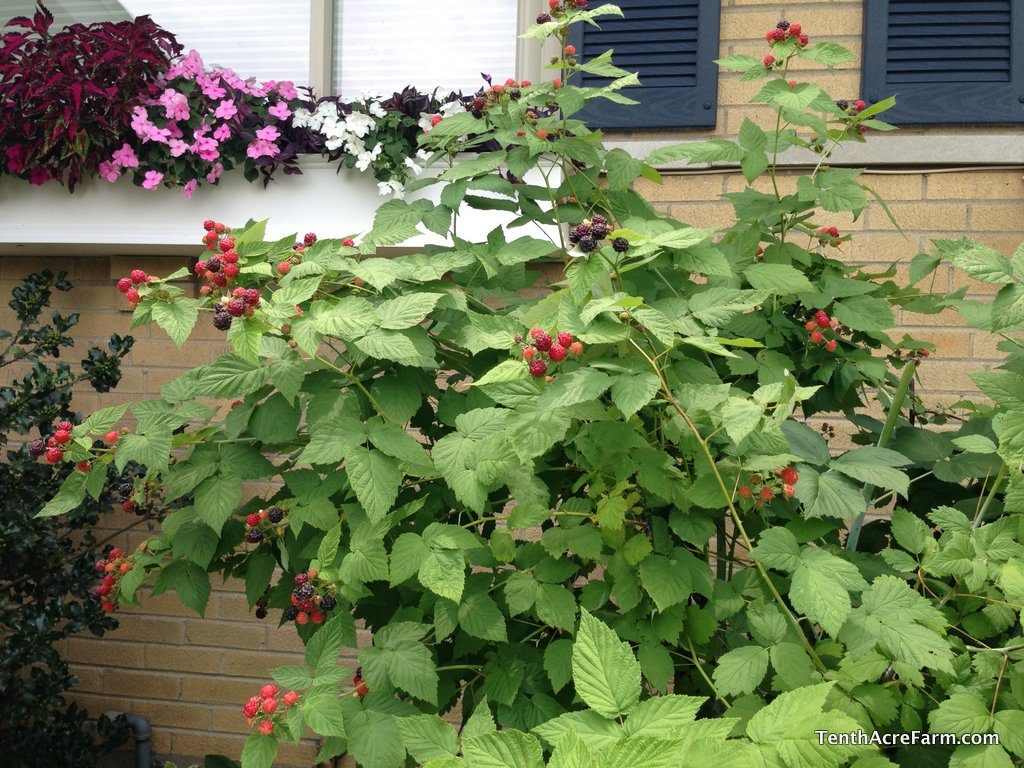
Black raspberries work well in the edible landscape because they are clumping (no “walking away” over time) and can be pruned to less than 3 feet tall. They are well adapted to USDA growing zones 5-9, along with thornless blackberries.
Berry-producing shrubs, everbearing strawberries, and fruit trees are all beautiful, come back every year with little work, and require less water than annual gardens.
Plant Long-Lasting Vegetable Crops
Leafy greens like Swiss chard, kale, and collards, as well as fruiting vegetables like tomatoes, peppers, and eggplants, all create “permanent” interest in the edible landscape during the growing season.
Leafy greens quickly grow back after each “leaf” harvest, while tomatoes and the like are plucked from plants that retain vibrant foliage. Grow container varieties of fruiting vegetables for compact and tidy plants.
Plant Herbs as Landscape Anchors
Identify a handful of perennial herb plants to repeat throughout the landscape. They will provide consistency, flowering beauty, and add culinary and medicinal value. You’ll also inspire a mini ecosystem to develop, as perennial herbs attract beneficial insects and repel pests.
They’ll even provide valuable nutrients to the soil when chopped back.
Model what you wish to see by being respectful of neighbors and sharing your joy of growing things. Plant a beautiful, tidy, edible landscape that supports a diverse array of plants and beneficial insects, and your neighbors are sure to love it as much as you do.
Don’t forget to smile and share your harvest!
If you’ve enjoyed today’s article, be sure to pick up a copy of Amy’s book. I greatly enjoyed it. You can learn more about Amy and follow her gardening adventures at Tenth Acre Farm.

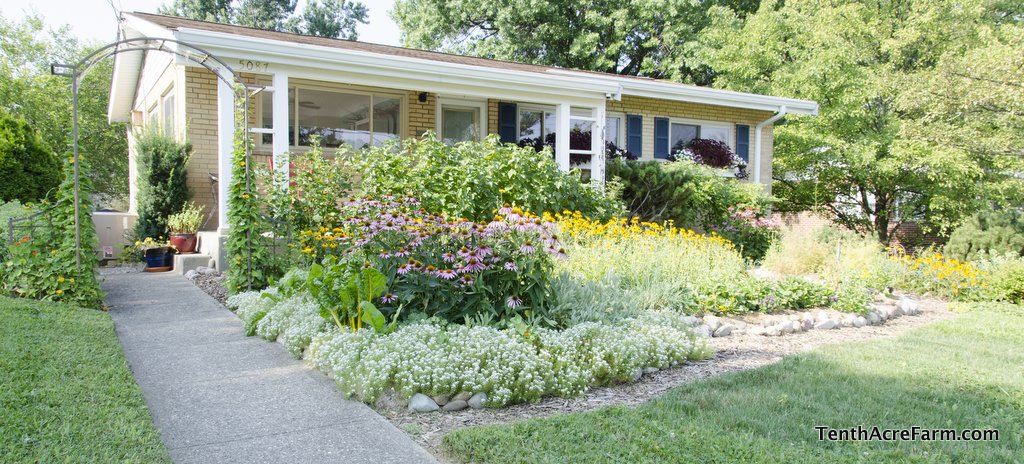
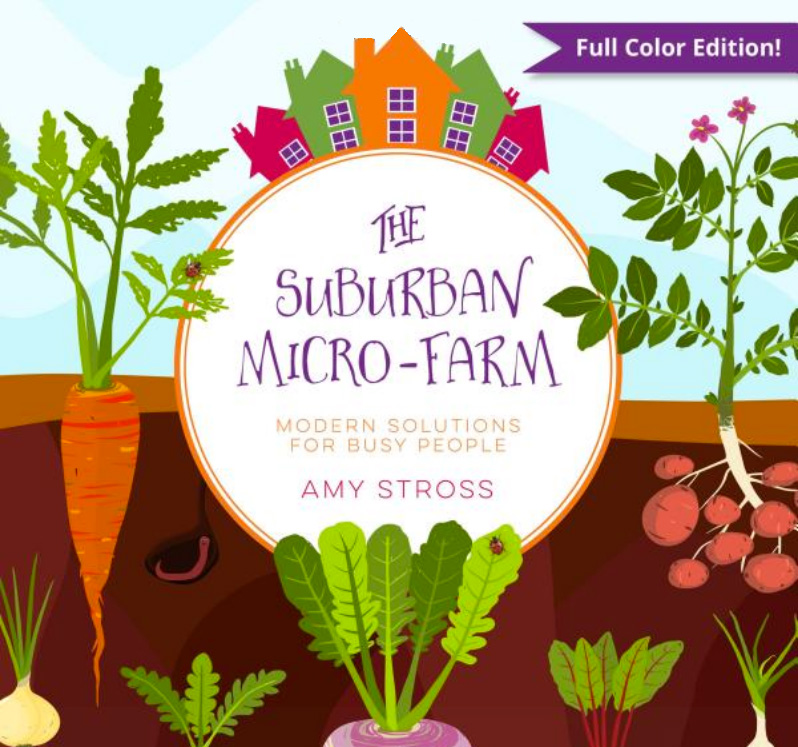
20 comments
Planting of triffids can solve any/all neighbor issues. [Ref: Day of the Triffids, by John Wyndham] :-)
Awesome.
I just read the Suburban Micro-Farm! I’m still in my first year of starting to convert more of the lawn into garden beds. It was super exciting to see the seeds growing in the beginning, but some of my plants started dying, which really was depressing. I had no idea why, and was about to give up because I was just so overwhelmed with not knowing what was going on! Then I read, “The first year of a new garden bed rarely produces abundantly or is pest or disease free because the soil organisms aren’t settled yet in the new home you’ve created for them.” So, I kept at it, and a few months later everything is doing much better. Super excited! Awesome book!
She’s got so many good tips in there it’s amazing. And that’s right – the beds need to balance over time. Good work, Samantha.
Great article! thanks!
Great article. It’s so true that educating others without being judgmental is the most effective way to get the end result you want. I’m an admin on a Snake Identification group on Facebook and we educate people without judgment and the amount of people that go from snake killers to sometimes even snake lovers is amazing.
Thanks for contributing, Amy. I have long thought this to be a great idea.
I keep hoping to spend time researching these ideas and DTG’s “Food Forest” (adapted for Indiana) for my lawn. I already will eat the organic dandelions in my yard from time to time. I need to make it more of a priority to scan and harvest fresh ones every day. They’re bitter so I don’t want them in salad every day. And I never thought to saute them until the other day when I saw the idea online.
Good in a smoothie too!
I bought that book after seeing David’s recommendation, and really enjoyed it! Now I need a book on how to garden with a toddler “assistant”! :P
I do have a garden related question – I have a patch of lily of the valley in my front flower garden, near a space I’d like to try planting with alpine strawberry. I’m planning to dig up the lilies and find a different home for them, but should I be concerned about residual toxicity?
Hi David,
you have any suggestions on edible perennials for the yard that is in complete shade? under two oaks, one is my neighbors that he won’t trim.
Thx
sorry located in central FL
Ginger and turmeric with both produce in the shade. You might also try growing grape mahonia, if you can find them. The fruit is good for jam.
Great ideas, DTG. The Florida climate is not my forte, but I wonder if aronia or mulberry would work, as well. They both do great in the shade.
Good idea. The dwarf mulberries are quite versatile.
I was wondering what can be done if your neighbor is not interested in changing their ways. In my case it would be an issue of over spray as they spray the fence and fence line with a weed killer (We and they are really over run with bittersweet vines). I’m thinking of some kind of buffer that’s resistant to roundup or whatever they’re using, if there is such a thing. I’m picturing arborvitae because of their denseness (just an example although I don’t know if it’s resistant) to stop any over spray. Any ideas? Any ideas to control bittersweet so I don’t join the other side? Thanks. I know I’m a little late to the party here. Great article!
Bittersweet can be a nuisance, so if both of you are dealing with it on the shared fenceline, then it is a good time to collaborate. Let your neighbor know that you want to work together to solve the problem, since if the problem isn’t solved, then the bittersweet overruns even more, and you assure more herbicide use. Vines will swallow most buffer plants given the chance, unfortunately.
The thing is, if your neighbor’s herbicide worked, there would be no more bittersweet. So we have to look for other solutions. My advice would be to look for an ecological landscaping company in your area who will do the manual labor to dig it/pull it out for you (bittersweet roots can be quite large if well established). The company may suggest using herbicide along with the physical removal. It is important to work with a company that is knowledgeable about the different families of herbicides, can select one that actually works on bittersweet, and knows how to be very targeted with a one-time application.
One of my favorite authors is Dave Jacke, who wrote ‘Edible Forest Gardens’ (vol. 2), changed my mind about selective use of herbicide. In my opinion, spraying dandelions in a lawn is an INappropriate use, whereas its limited use on an aggressive plant species may be warranted if it is in an area that you really want to maintain.
If you and your neighbor could agree to split the cost of the landscaper work, that would be another step toward forming an alliance rather than being adversaries. ‘Hey, would you be interested in going in with me to get rid of this once and for all?’ My new neighbor and I recently split the cost to remove a tree on the fenceline. It can be intimidating and challenging to work together, but when you offer to meet them in the middle with a particular project, it can go a long way.
There are many families of herbicides, and I don’t suggest their use lightly. It’s important to know which will dissipate fairly quickly vs those which persist in the soil, and which will wreak havoc on your healthy soil with no actual results.
If you can get to this place with your neighbor…bittersweet is gone, you have a clean slate, and you and your neighbor have accomplished something together… then it would be an excellent time to have the conversation about how you are trying to grow food without chemicals, and perhaps you could pay the difference if s/he chose an organic weed prevention? (FYI, I like corn gluten meal for sprinkling under a chain-link fence.)
Now you can plant your hedgerow of non-edible shrubs for extra protection.
This is very helpful. Thank you! Their herbicide did work for the most part on the fence line …I see a few distorted green sprouts so it will be back if we don’t keep on it. I thought of getting a weed dragon (https://amzn.to/2QoWb6b). Their yard has less bittersweet now (because they spray it I assume), ours is crazy with that and another vine I can’t remember the name of that’s encroaching from a wooded lot next door – oh and those briars. Most of the time I can pull up the vines and their 10-20-foot roots. I haven’t been well, so it’s been hard to keep up with it. I’m going to get a ‘work party’ together with my adult kids this fall and again in the spring to try to get this half-acre straightened out (combined with a nice cookout and hopefully lots of laughs). Anyway, I’m rambling. Thank you very much for your response and advice. w~
A work party sounds like an excellent idea! And flame weeders work pretty well, but they obviously wouldn’t be a good idea around a wooden fence or anything that could catch fire. They are surprisingly powerful. :-)
[…] Amy Stross wrote a very good article here a few years back covering how she used edible landscaping to both grow food and improve the look of her […]
Amy Stross’ book was my introduction to currants as a landscape plant, which si why i hunted down some currants and finally ate one. fell in love, and planted hedges full.
Comments are closed.